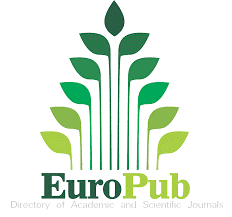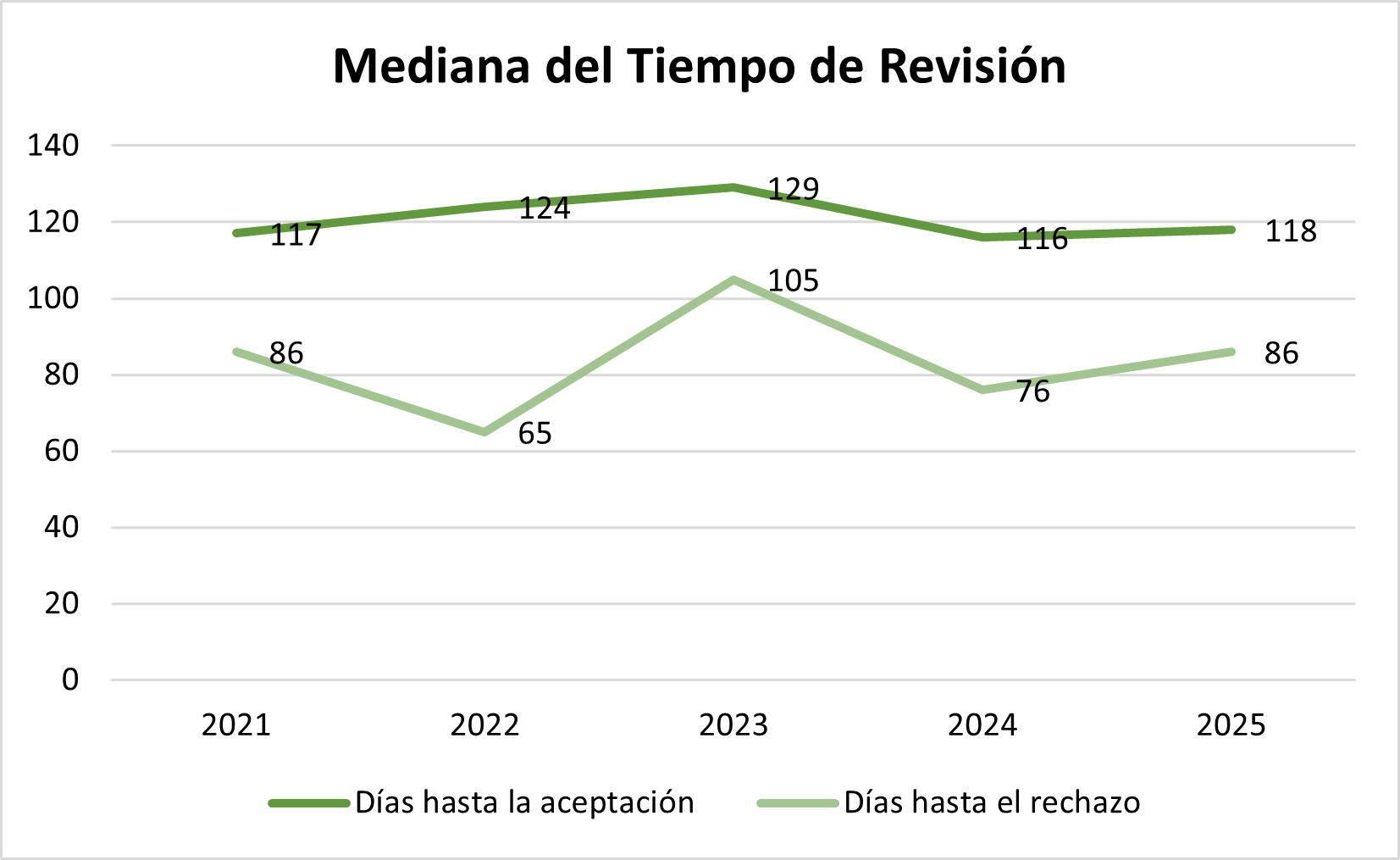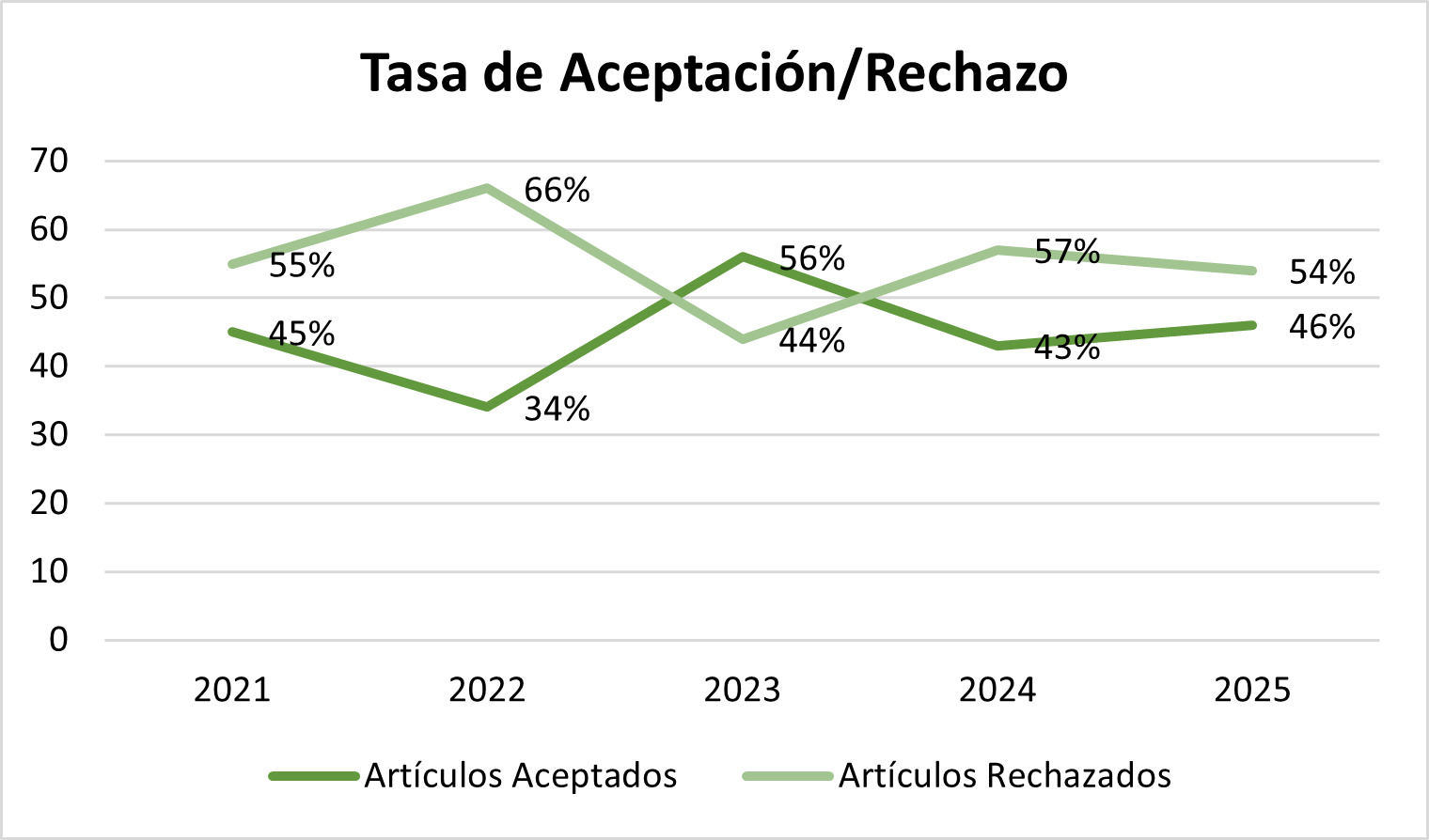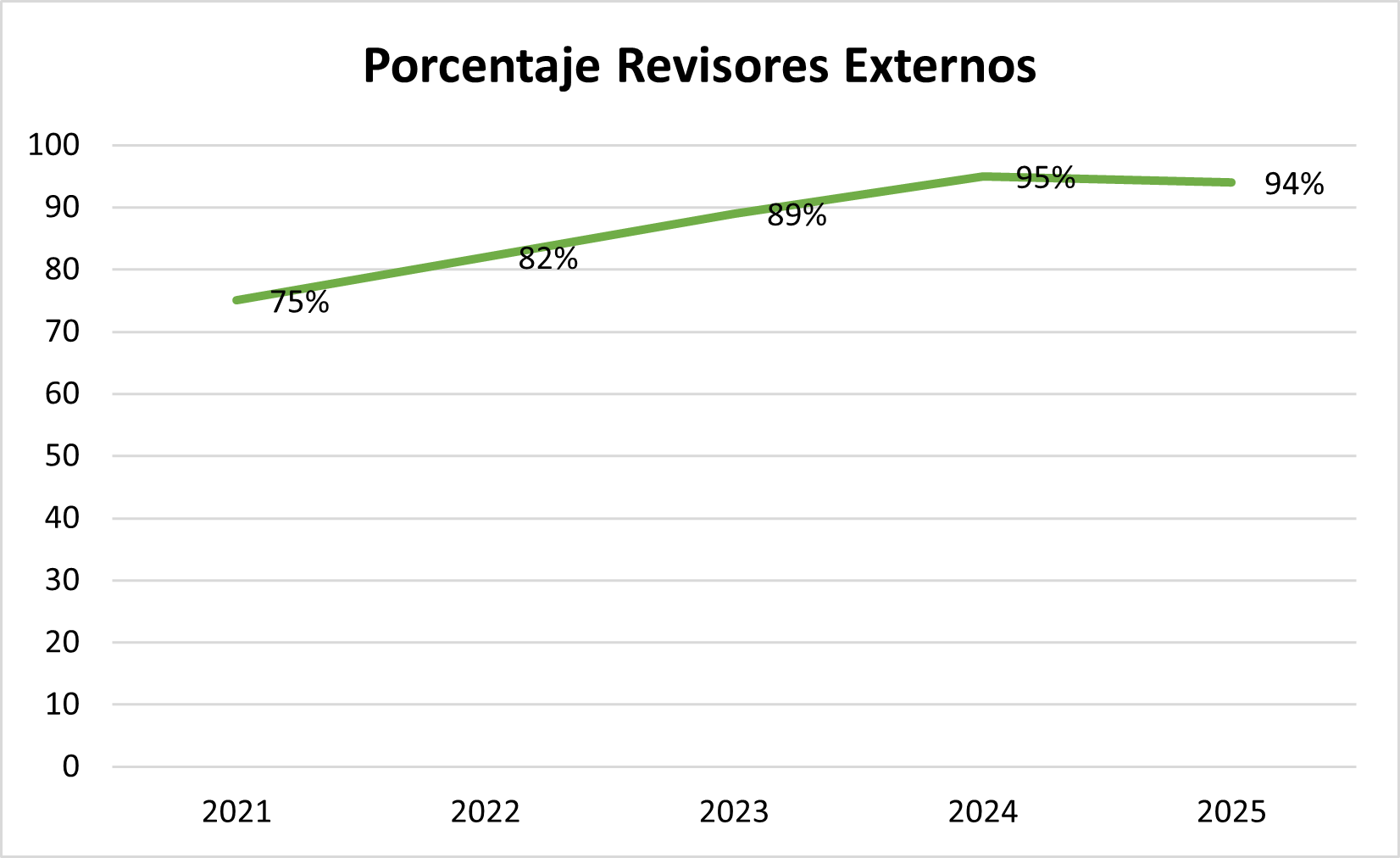Estado actual del uso de marcadores moleculares en el diagnóstico y control genético de enfermedades de naranjilla
Palabras clave:
Naranjilla, marcadores moleculares, enfermedadesResumen
La naranjilla o lulo (Solanum quitoense) es un importante cultivo frutal originario del noroeste de Sudamérica que se siembra principalmente en Colombia y Ecuador. Este cultivo tiene cada vez tiene mayor demanda a nivel mundial. Sin embargo, es muy susceptible al ataque de plagas y enfermedades. En el Ecuador, los principales patógenos que atacan a la naranjilla son Fusarium oxysporum, Meloidogyne incognita. Además, se ha detectado un virus de la familia Tymoviridae, a la que se denominó Naranjilla chlorotic mosaic virus (NarCMV) y un viru que causa mosaico al que se ha denominado Naranjilla mild mosaic virus (NarMMV). La presencia de estos patógenos ha sido detectada con el uso de diferentes técnicas moleculares. El presente reporte presenta el estado actual en el uso de marcadores moleculares, tanto en el diagnóstico de enfermedades, como en la detección de información relacionada a la resistencia en el cultivo de naranjilla.Citas
Alwang, J., Suárez, C. y Barrera, V. (2002). Overview of the South American site in Ecuador. Blacksburg, VA: Integrated Pest Management Collaborative Research Support Program.
Barbary, A., Djian-Caporalino, C., Palloix, A. y Castagnone-Sereno, P. (2015). Host genetic resistance to root-knot nematodes, Meloidogyne spp., in Solanaceae: from genes to the field. Pest Management Science, 71(12), 1591–1598. https://doi.org/10.1002/ps.4091.
Bedoya-Reina, O.C. y Barrero, L.S. (2010). Preliminary assessment of COSII gene diversity in lulo and a relative species: Initial identification of genes potentially associated with domestication. Gene, 458(1), 27–36. https://doi.org/10.1016/j.gene.2010.03.005.
Boix-Ruíz, A., Gálvez-Patón, L., de Cara-García, M., Palmero-Llamas, D., Camacho-Ferre, F. y Tello-Marquina, J.C. (2015). Comparison of analytical techniques used to identify tomato-pathogenic strains of Fusarium oxysporum. Phytoparasitica, 43(4), 471–483. https://doi.org/10.1007/s12600-014-0444-z.
Chong, L., y Andrade, F. (2001). Exportación de naranjilla en conserva hacia los Estados Unidos y sus efectos en la economía ecuatoriana. Disponible en: https://www.dspace.espol.edu.ec/bitstream/123456789/3519/1/6046.pdf
Clements, C., Alwang, J., Barrera, V. y Dominguez, J.M. (2017). Graft is good: the economic and environmental benefits of grafted naranjilla in the Andean region. Renewable Agriculture and Food Systems, 32(4), 306–318. https://doi.org/10.1017/S174217051600020X.
Çolak, A. y Biçici, M. (2013). PCR detection of Fusarium oxysporum f. sp. radicis-lycopersici and races of F. oxysporum f. sp. lycopersici of tomato in protected tomato-growing areas of the eastern Mediterranean region of Turkey. Turkish Journal of Agriculture and Forestry, 37, 457–467. https://doi.org/10.3906/tar-1203-71.
Cornejo-Franco, J.F., Alvarez-Quinto, R.A., Grinstead, S., Mollov, D., Karasev, A.V, Ochoa, J. y Quito-Avila, D.F. (2019). A new tymovirus isolated from Solanum quitoense: characterization and prevalence in two solanaceous crops in Ecuador. Plant Disease, 103(9), 2246–2251. https://doi.org/10.1094/PDIS-01-19-0113-RE.
Council, N.R. (1989). Lost crops of the Incas: little-known plants of the Andes with promise for worldwide cultivation. Washington, DC: The National Academies Press. https://doi.org/10.17226/1398.
Dennis, F.G., Herner, R.C. y Camacho, S. (1985). Naranjilla: A potential cash crop for the small farmer in Latin America. Acta Horticulturae, 158, 475–481. http://doi.org/10.17660/ActaHortic.1985.158.55.
El-Sappah, A.H., Islam, M.M., El-awady, H. H., Yan, S., Qi, S., Liu, J. y Liang, Y. (2019). Tomato natural resistance genes in controlling the root-knot nematode. Genes, 10(11). https://doi.org/10.3390/genes10110925.
Enciso-Rodríguez, F., Martínez, R., Lobo, M. y Barrero, L.S. (2010). Genetic variation in the Solanaceae fruit bearing species lulo and tree tomato revealed by Conserved Ortholog (COSII) markers. Genetics and Molecular Biology, 33(2), 271-278. https://doi.org/10.1590/S1415-47572010005000016.
Fory Sánchez, P.A., Sánchez Mosquera, I., Bohórquez Cháux, A., Ramírez, H., Medina Cano, C.I. y Lobo Arias, M. (2010). Genetic variability of the colombian collection of lulo (Solanum quitoense Lam.) and related species of section Lasiocarpa. Revista Facultad Nacional de Agronomía, Medellín, 63(2), 5465-5476. Disponible en: http://www.redalyc.org/articulo.oa?id=179918602001.
Gallo, Y., Toro, L.F., Jaramillo, H., Gutiérrez, P.A. y Marín, M. (2018). Identificación y caracterización molecular del genoma completo de tres virus en cultivos de lulo (Solanum quitoense) de Antioquia (Colombia). Revista Colombiana de Ciencias Hortícolas, 12(2). https://doi.org/10.17584/rcch.2018v12i2.7692.
Gancel, A.L., Alter, P., Dhuique-Mayer, C., Ruales, J. y Vaillant, F. (2008). Identifying carotenoids and phenolic compounds in naranjilla (Solanum quitoense Lam. Var. Puyo Hybrid), an andean fruit. Journal of Agricultural and Food Chemistry, 56(24), 11890–11899. https://doi.org/10.1021/jf801515p.
Gao, R. y Zhang, G. (2013). Potential of DNA barcoding for detecting quarantine fungi. Phytopathology, 103, 1103–1107. http://dx.doi.org/10.1094/PHYTO-12-12-0321-R.
Gelpud, C., Mora, E., Salazar, C. y Betancourth, C. (2011). Susceptibilidad de genotipos de Solanum spp. al nematodo causante del nudo radical Meloidogyne spp. (Chitwood). Acta Agronómica, 60(1), 50-67. Disponible en: https://www.redalyc.org/articulo.oa?id=169922363005.
Green, K.J., Mollov, D., Tran, L.T., Alvarez-Quinto, R.A., Ochoa, J.B., Quito-Avila, D.F. y Karasev, A.V. (2017). Characterization of a new tymovirus causing stunting and chlorotic mosaic in naranjilla (Solanum quitoense). Plant Disease, 102(5), 911–918. https://doi.org/10.1094/PDIS-10-17-1534-RE.
Grijalva, J. (2005). Expansion of Livestock in the Amazon and its Impact on Deforestation in the Ecuadorian Context [dissertation]. Paris France: Institut National Agronomique de Paris-Grignon, National Agronomic University of Paris-Grignon.
Heiser, C.B. (1993). The naranjilla (Solanum quitoense), the cocona (Solanum sessiliflorum) and their hybrid. En: Gene Conservation and Exploitation. Gustafson J.P., Appels R., Raven P. (eds). Stadler Genetics Symposia Series. Springer, Boston, MA. https://doi.org/10.1007/978-1-4899-1136-0_3.
Hirano, Y. y Arie, T. (2006). PCR-based differentiation of Fusarium oxysporum f. sp. lycopersici and radicislycopersici and races of F. oxysporum f. sp. lycopersici. Journal of General Plant Pathology, 72, 273–283. https://doi.org/10.1007/s10327-006-0287-7.
Khan, M.R. y Sharma, R.K. (2020). Fusarium-nematode wilt disease complexes, etiology and mechanism of development. Indian Phytopathology, 73(4), 615–628. https://doi.org/10.1007/s42360-020-00240-z.
Kumar, N., Bhatt, J. y Sharma, R. (2017). Interaction between Meloidogyne incognita with Fusarium oxysporum f. sp. lycpersici on tomato. International Journal of Current Microbiology and Applied Sciences, 6, 1770–1776. https://doi.org/10.20546/ijcmas.2017.608.209.
Lim, T.K. (2013). Solanum lasiocarpum BT - Edible medicinal and non-medicinal plants: Volume 6, Fruits. In T. K. Lim (Ed.) (pp. 333–335). Dordrecht: Springer Netherlands. https://doi.org/10.1007/978-94-007-5628-1_39.
Leslie, J.F. y Summerell, B.A. (2006). The Fusarium laboratory manual. Ames, IA, USA: Blackwell Publishing.
Lievens, B., Van Baarlen, P., Verreth, C., Van Kerckhove, S., Rep, M. y Thomma, B.P. (2009b). Evolutionary relationships between Fusarium oxysporum f. sp. lycopersici and F. oxysporum f. sp. radicis-lycopersici isolates inferred from mating type, elongation factor-1a and exopolygalacturonase sequences. Mycological Research, 113, 1181–1191. https://doi.org/10.1016/j.mycres.2009.07.019.
Navarrete, X., Ron, L., Viteri, P., y Viera, W. (2018). Parasitism of the root knot nematode Meloidogyne incognita (Kofoid and White) chitwood in five wild Solanaceae species. Revista Facultad Nacional de Agronomía Medellín, 71, 8367–8373. https://doi.org/10.15446/rfna.v71n1.67122.
Martínez-Gallardo, J.A., Díaz-Valdés, T., Allende-Molar, R. y Retes-Manjarrez, J.E., Carrillo-Fasio, J.A. (2019). Identificación y distribución de Meloidogyne spp. en tomate de Sinaloa México. Revista Mexicana de Ciencias Agrícolas, 10, 453–459. http://dx.doi.org/10.29312/remexca.v10i2.392.
Martínez, M. (2021). Identificación molecular y caracterización de síntomas de aislados virales de naranjilla en 3 especies de la sección Lasiocarpa (S. quitoense, S. hirtum y S. sessiflorum). Tesis Ing. Agr. Universidad de Cuenca.
Meena, K., Ramyabharathi, S.A., Raguchander, T. y Jonathan, E.I. (2016). Interaction of Meloidogyne incognita and Fusarium oxysporum in carnation and physiological changes induced in plants due to the interaction. SAARC Journal of Agriculture, 14(1). https://doi.org/10.3329/sja.v14i1.29576.
Mosquera-Espinosa, A.T. (2016). Fitonematodos asociados a Cyphomandra betacea (Cav.) Sendtn., Solanum quitoense Lam. y Daucus carota L. en el Departamento de Boyacá, Colombia. Acta Agronómica, 65, 87–97. https://doi.org/10.15446/acag.v65n1.45180.
Oliveira, D., Alves, C.M., Barbosa, C., Ribeiro,M. L., Santos, M T., Menezes, V.L., et al. (2013). Identification of races 1, 2 and 3 of Fusarium oxysporum f. sp. lycopersici by molecular markers. African Journal of. Microbiological Research, 7, 2324–2331. https://doi.org/10.5897/AJMR12.2234
Pacheco, L. (2019). Determinación de la resistencia a Meloidogyne incognita, en tres especies de la sección Lasiocarpa: Solanum quitoense, Solanum hirtum y Solanum sp. Tesis Ing. Agr. Universidad de Cuenca.
Pratt, R.C., Francis D.M. y Meneses L.S.B. (2008). Genomics of tropical solanaceous species: established and emerging crops. En: Genomics of Tropical Crop Plants. Moore P.H., Ming R. (eds), New York: Plant Genetics and Genomics: Crops and Models, vol 1. https://doi: 10.1007/978-0-387-71219-2_19.
Ramírez, F., Kallarackal, J., & Davenport, T. L. (2018). Lulo (Solanum quitoense Lam.) reproductive physiology: A review. Scientia Horticulturae, 238, 163–176. https://doi.org/10.1016/j.scienta.2018.04.046.
Reyna, E. (2021). Evaluación de la resistencia a la interacción entre Meloidogyne incognita y Fusarium oxysporum en dos especies de la sección Lasiocarpa: Solanum hirtum y Solanum sp. Tesis Ing. Agr. Universidad de Cuenca.
Sowell, A. y Shively, G. (2012). Economic and environmental impacts of grafted naranjilla. Forests, Trees and Livelihoods, 21(1), 30–43. https://doi.org/10.1080/14728028.2012.669133.
Vaca, J., Torres, I., Peñaranda, J., & Aristizábal, F. (1999). Identificación de potivirus presentes en plantas de lulo (Solanum quitoense Lam). Revista Colombiana de Biotecnología, 2(2), 9–15. Retrieved from: https://revistas.unal.edu.co/index.php/biotecnologia/article/view/30046.
Whalen, M.D. y Caruso, E.E. (1983). Phylogeny in Solanum sect. Lasiocarpa (Solanaceae): Congruence of Morphological and Molecular Data. Systematic Botany, 8(4), 369–380. https://doi.org/10.2307/2418356.
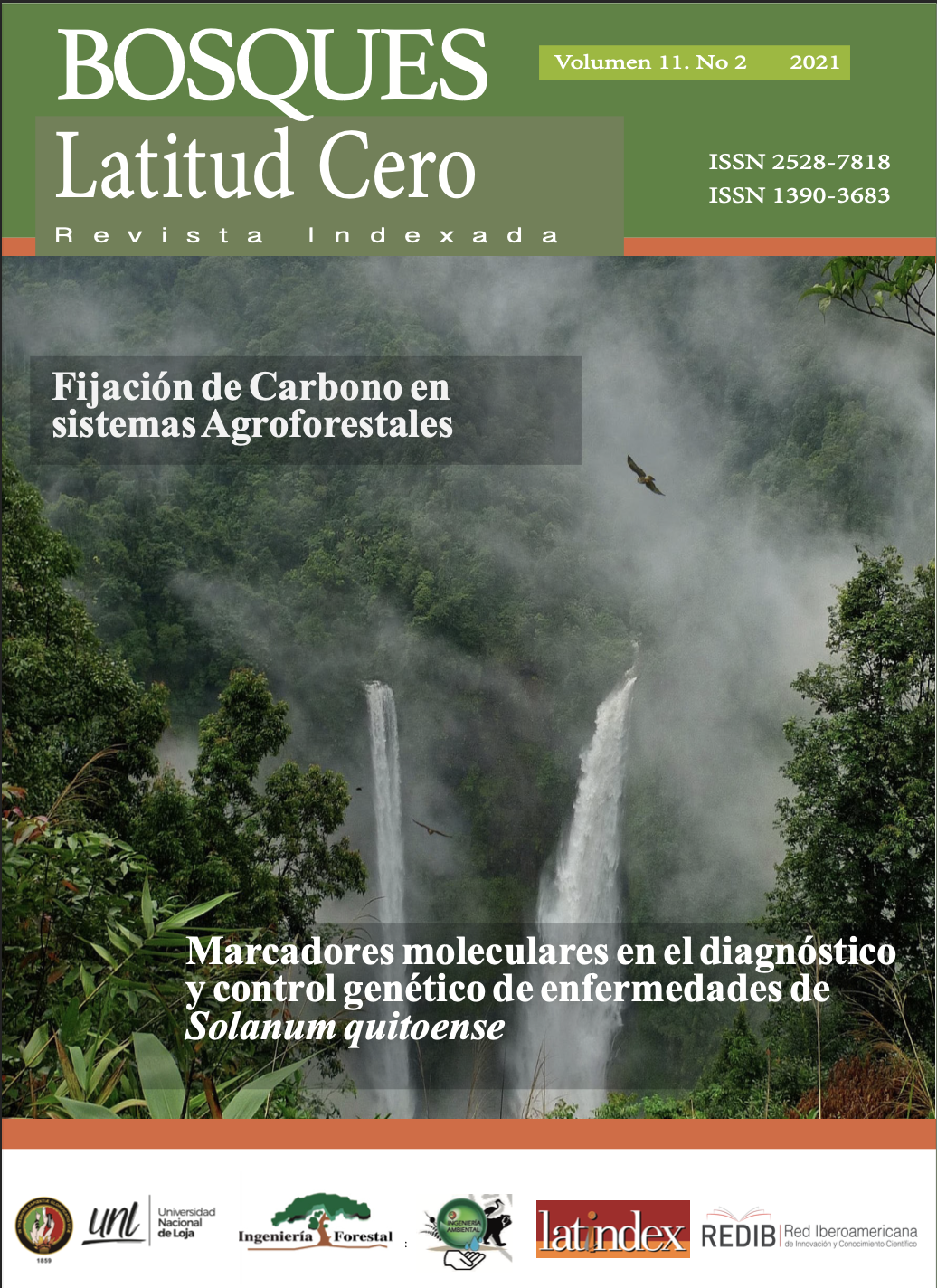
Publicado
Cómo citar
Número
Sección
Licencia
Derechos de autor 2021 Bosques Latitud Cero

Esta obra está bajo una licencia internacional Creative Commons Atribución-NoComercial-CompartirIgual 4.0.
Esta obra se publica bajo la licencia Creative Commons Atribución-NoComercial-CompartirIgual 4.0 Internacional (CC BY-NC-SA 4.0). Esto significa que los usuarios pueden copiar, distribuir y adaptar el contenido, siempre que se otorgue el crédito adecuado a los autores y a la revista. No se permite el uso comercial del material. Además, cualquier obra derivada debe distribuirse bajo la misma licencia. Esta licencia garantiza el acceso abierto al conocimiento, promoviendo la difusión y reutilización de los trabajos publicados sin fines de lucro, respetando la autoría y asegurando la libre circulación del contenido en términos equitativos.














